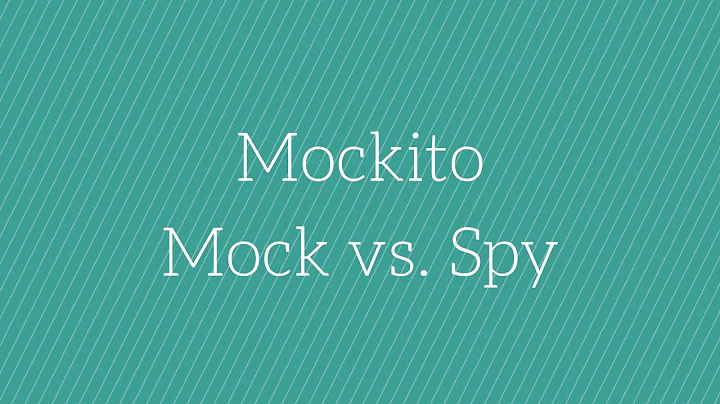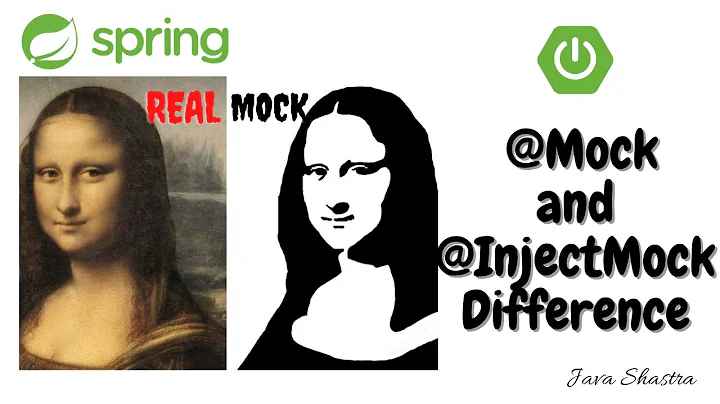Difference between @Mock, @MockBean and Mockito.mock()
Solution 1
Plain Mockito library
import org.mockito.Mock;
...
@Mock
MyService myservice;
and
import org.mockito.Mockito;
...
MyService myservice = Mockito.mock(MyService.class);
come from the Mockito library and are functionally equivalent.
They allow to mock a class or an interface and to record and verify behaviors on it.
The way using annotation is shorter, so preferable and often preferred.
Note that to enable Mockito annotations during test executions, the
MockitoAnnotations.initMocks(this) static method has to be called.
To avoid side effect between tests, it is advised to do it before each test execution :
@Before
public void initMocks() {
MockitoAnnotations.initMocks(this);
}
Another way to enable Mockito annotations is annotating the test class with @RunWith by specifying the MockitoJUnitRunner that does this task and also other useful things :
@RunWith(org.mockito.runners.MockitoJUnitRunner.class)
public MyClassTest{...}
Spring Boot library wrapping Mockito library
This is indeed a Spring Boot class:
import org.springframework.boot.test.mock.mockito.MockBean;
...
@MockBean
MyService myservice;
The class is included in the spring-boot-test library.
It allows to add Mockito mocks in a Spring ApplicationContext.
If a bean, compatible with the declared class exists in the context, it replaces it by the mock.
If it is not the case, it adds the mock in the context as a bean.
Javadoc reference :
Annotation that can be used to add mocks to a Spring ApplicationContext.
...
If any existing single bean of the same type defined in the context will be replaced by the mock, if no existing bean is defined a new one will be added.
When use classic/plain Mockito and when use @MockBean from Spring Boot ?
Unit tests are designed to test a component in isolation from other components and unit tests have also a requirement : being as fast as possible in terms of execution time as these tests may be executed each day dozen times on the developer machines.
Consequently, here is a simple guideline :
As you write a test that doesn't need any dependencies from the Spring Boot container, the classic/plain Mockito is the way to follow : it is fast and favors the isolation of the tested component.
If your test needs to rely on the Spring Boot container and you want also to add or mock one of the container beans : @MockBean from Spring Boot is the way.
Typical usage of Spring Boot @MockBean
As we write a test class annotated with @WebMvcTest (web test slice).
The Spring Boot documentation summarizes that very well :
Often
@WebMvcTestwill be limited to a single controller and used in combination with@MockBeanto provide mock implementations for required collaborators.
Here is an example :
import org.junit.Test;
import org.junit.runner.RunWith;
import org.mockito.Mockito;
import org.springframework.beans.factory.annotation.Autowired;
import org.springframework.boot.test.autoconfigure.web.servlet.WebMvcTest;
import org.springframework.boot.test.mock.mockito.MockBean;
import org.springframework.http.MediaType;
import org.springframework.test.context.junit4.SpringRunner;
import org.springframework.test.web.servlet.MockMvc;
import static org.springframework.test.web.servlet.request.MockMvcRequestBuilders.*;
import static org.springframework.test.web.servlet.result.MockMvcResultMatchers.*;
@RunWith(SpringRunner.class)
@WebMvcTest(FooController.class)
public class FooControllerTest {
@Autowired
private MockMvc mvc;
@MockBean
private FooService fooServiceMock;
@Test
public void testExample() throws Exception {
Foo mockedFoo = new Foo("one", "two");
Mockito.when(fooServiceMock.get(1))
.thenReturn(mockedFoo);
mvc.perform(get("foos/1")
.accept(MediaType.TEXT_PLAIN))
.andExpect(status().isOk())
.andExpect(content().string("one two"));
}
}
Solution 2
At the end its easy to explain. If you just look into the javadocs of the annotations you will see the differences:
@Mock: (org.mockito.Mock)
Mark a field as a mock.
- Allows shorthand mock creation.
- Minimizes repetitive mock creation code.
- Makes the test class more readable.
- Makes the verification error easier to read because the field name is used to identify the mock.
@MockBean: (org.springframework.boot.test.mock.mockito.MockBean)
Annotation that can be used to add mocks to a Spring ApplicationContext. Can be used as a class level annotation or on fields in either
@Configurationclasses, or test classes that are@RunWiththe SpringRunner.
Mocks can be registered by type or by bean name. Any existing single bean of the same type defined in the context will be replaced by the mock, if no existing bean is defined a new one will be added.
When
@MockBeanis used on a field, as well as being registered in the application context, the mock will also be injected into the field.
Mockito.mock()
Its just the representation of a
@Mock.
Related videos on Youtube
Doug
Software engineer with extensive experience working across the full development stack (backend, frontend, DevOps). Passionated about JavaScript, React and functional paradigm.
Updated on April 22, 2022Comments
-
 Doug about 2 years
Doug about 2 yearsWhen creating tests and mocking dependencies, what is the difference between these three approaches?
@MockBean:
@MockBean MyService myservice;@Mock:
@Mock MyService myservice;Mockito.mock()
MyService myservice = Mockito.mock(MyService.class);
-
 Florian Schaetz almost 7 yearsLet's not forget that @Mock requires the MockitoRunner or initMocks being called manually.
Florian Schaetz almost 7 yearsLet's not forget that @Mock requires the MockitoRunner or initMocks being called manually. -
 Doug almost 7 yearsWill using @MockBean create a copy of the bean and inject it to the ApplicationContext? Or will the mocked bean have all its methods as null? If all the methods are null can I stub them like I can do using @Mock?
Doug almost 7 yearsWill using @MockBean create a copy of the bean and inject it to the ApplicationContext? Or will the mocked bean have all its methods as null? If all the methods are null can I stub them like I can do using @Mock? -
 Doug almost 7 yearsIs the only difference between
Doug almost 7 yearsIs the only difference between@MockBeanand@Mockthat one will inject the mock into theSpring ApplicationContextand the other won't? -
 davidxxx almost 7 yearsAs explained, using
davidxxx almost 7 yearsAs explained, using@MockBeanwill replace the bean in the application context if a bean declaring the same type is already defined in your Spring configuration. And the injection is performed in the class where you declare@MockBean.The DI mechanisms works in this way : you register an object in the DI context and then you can inject the object referenced in the Spring context in a specific class. You don't inject an object in the DI context. -
 comiventor over 5 years@Doug You summarized it well but one needs to remember that MockBean is part of Spring Boot
comiventor over 5 years@Doug You summarized it well but one needs to remember that MockBean is part of Spring Boot -
Jaison Varghese over 3 yearsTo use
@MockBeanyou would need to annotate the class with@RunWith(SpringRunner.class). However for using@Mockyou can use@RunWith(MockitoJUnitRunner.class)and call initMocks() as @Florian-schaetz mentioned.@Mockwill work with SpringRunner as well but with the added overhead of loading the applicationContext -
JayC over 2 yearsI am following but how come the service class have 0 % coverage?







